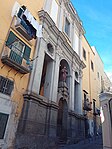Napoli Mergellina railway station
1925 establishments in ItalyRailway stations in NaplesRailway stations opened in 1925

Napoli Mergellina railway station (Italian: Stazione di Napoli Mergellina) serves the city and comune of Naples, in the region of Campania, Southern Italy. Opened in 1925, it is the third most important railway station in Naples, after Napoli Centrale and Napoli Campi Flegrei. It also forms part of the Villa Literno–Napoli Gianturco railway. The station is currently managed by Rete Ferroviaria Italiana (RFI). However, the commercial area of the passenger building is managed by Centostazioni. Train services are operated by Trenitalia. Each of these companies is a subsidiary of Ferrovie dello Stato (FS), Italy's state-owned rail company.
Excerpt from the Wikipedia article Napoli Mergellina railway station (License: CC BY-SA 3.0, Authors, Images).Napoli Mergellina railway station
Corso Vittorio Emanuele, Naples Chiaia
Geographical coordinates (GPS) Address Phone number Website Nearby Places Show on map
Geographical coordinates (GPS)
| Latitude | Longitude |
|---|---|
| N 40.831388888889 ° | E 14.219166666667 ° |
Address
Metro 900
Corso Vittorio Emanuele 6
80122 Naples, Chiaia
Campania, Italy
Open on Google Maps










